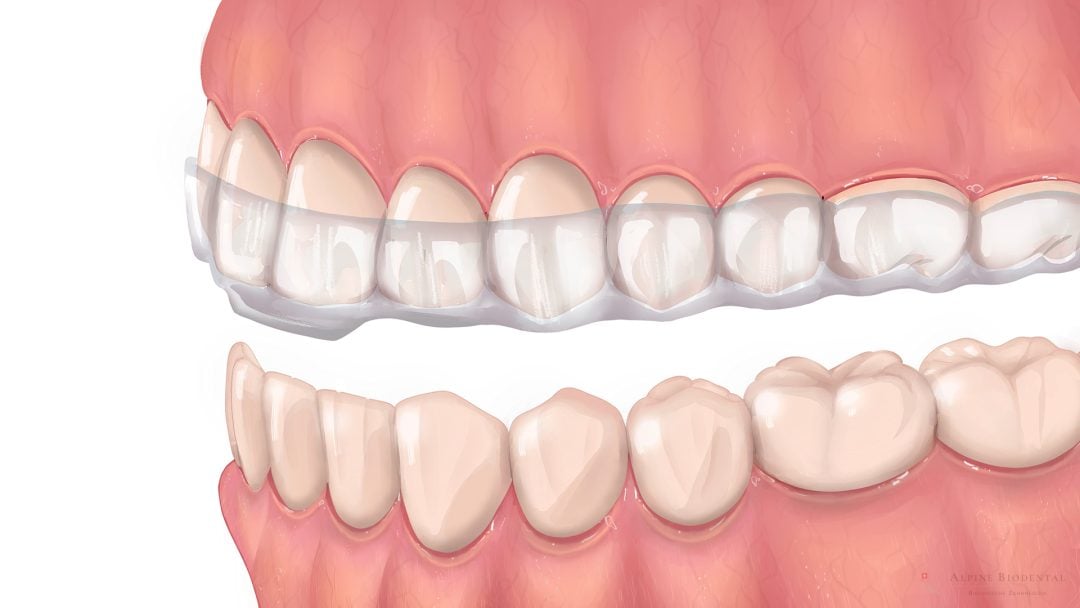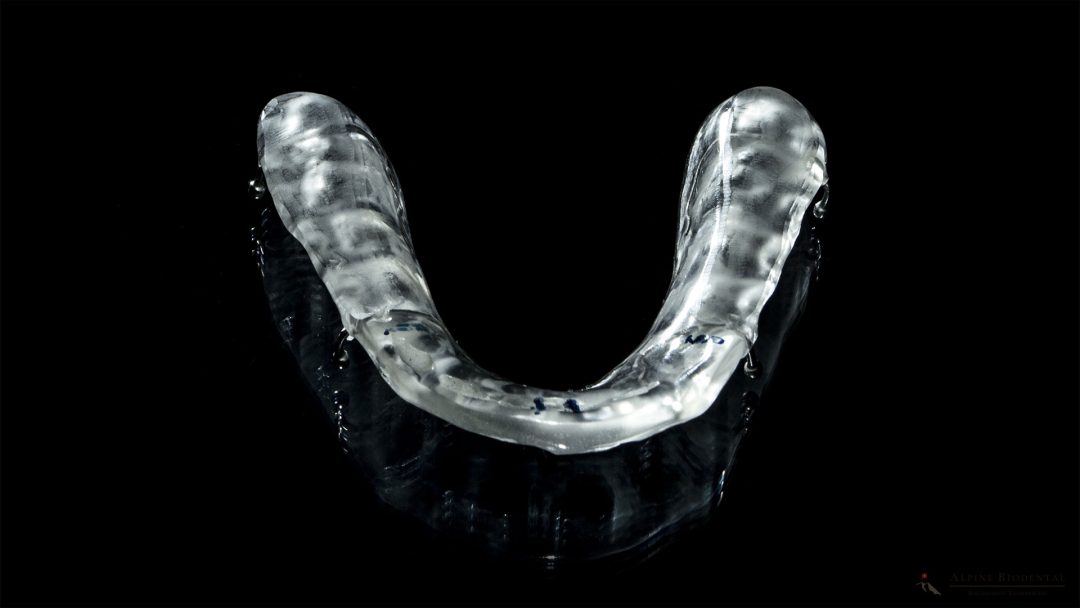Dental Splints
A dental splint is a dental apparatus made of transparent plastic that is worn in the upper or lower jaw. Depending on the shape, hardness, and manufacturing process, dental aligners differ in their function, effectiveness, and biology.
This article focuses on dental aligners in general, with specific subcategories explained in other posts.
TMJ Splint
The A-PRF method describes blood plasma membranes that are inserted into the wounds and sutured. This helps with wound healing after surgery.

Types of Dental Splints
There are various types of dental aligners that serve different functions and have broad applications in dentistry. Dental aligners can be used for conditions such as temporomandibular disorders of the joints (TMJ), misaligned teeth, or snoring.
In this section, we will explore the different types of dental aligners to provide you with a comprehensive overview.
Clear Splints for Tooth Correction (Aligners)
Clear aligners for tooth correction are also known as aligners. These transparent trays function similarly to braces, correcting tooth misalignments. Often referred to as “invisible braces,” it’s worth noting that the aligner can be noticeable upon close inspection. The use of aligners is an elegant option for adults looking to align their teeth aesthetically.
In the realm of aligners, the term “Invisalign” frequently emerges. Invisalign is a well-known and widely used brand for clear braces.
Splints for the Treatment of TMJ Disorders and Bruxism
Splints used for treating bruxism and relaxing the jaw muscles are known as occlusal splints or bruxism splints. Terms like bite splint or Michigan splint are also commonly used. These occlusal splints aim to protect the teeth from grinding and promote relaxation of the chewing system.
In addition to protecting the teeth and muscle relaxation, many individuals require correction of the temporomandibular joints (TMJ). This aspect is the most complex and demands specific knowledge and experience from the practitioner in the field of temporomandibular joint disorders (TMJ).
For the treatment of TMJ, various types of TMJ-splints can be used. Examples include the Dros splint, DIR splint, or MAGO splint. Each of these splints is integrated into a different therapeutic concept, with the treatment being carried out in diverse ways. It is crucial that TMJ therapy addresses the root cause and ensures long-term stability.
It is advisable to manufacture the occlusal splint in the upper jaw, as there are sensory advantages compared to a splint in the lower jaw.

Anti-Snoring Devices / Mandibular Advancement Device
Anti-snoring devices, also known as mandibular advancement devices, are designed to prevent nocturnal snoring in patients by slightly pushing the lower jaw forward (protrusion). Consequently, the snoring device is also referred to as a mandibular advancement device.
Snoring results from the relaxation of the muscles in the throat, palate, and tongue. The relaxed throat muscles struggle to keep the airways fully open. Additionally, the tongue may “fall” backward, further obstructing the airway. The unphysiological airflow and relaxed tissues create vibrations, generating noise levels of up to 90 dB, equivalent to a busy street.
The anti-snoring or mandibular advancement device is capable of moving the lower jaw, and consequently, the tongue forward, opening the airways to prevent snoring. This approach is purely symptomatic therapy.
It is crucial for a specialist to identify the cause of snoring and pursue causal therapy, potentially in combination with an anti-snoring device.
How to Clean a Dental Splint?
To clean a dental splint, follow these steps:
Use a mild, transparent liquid soap or clear dishwashing detergent along with a soft toothbrush.
Moisten the splint and the toothbrush with water, add a small amount of the liquid soap or detergent, and brush the splint thoroughly.
Rinse the dental splint thoroughly with water to remove any soap residue.
Avoid using aggressive or abrasive soaps or toothpaste for cleaning. Also, refrain from using home remedies such as baking soda or vinegar, as these can roughen the surface of the splint and damage the material.
Materials of Dental Splints
Dental splints can be either soft or hard, depending on the material used. We strongly recommend hard dental splints and advise against the use of soft materials. Soft materials are interpreted by dental receptors as soft food, leading to constant muscle activity through reflex arcs.
The following plastics can be used as materials for dental splints:
- Poly-Methyl-Meth-Acrylate (PMMA)
- Polyethylene Terephthalate (PET)
- Polyethylene Terephthalate Glycol Copolyester (PET-G)
- Urethane Di-Meth-Acrylate (UDMA)
- Urethane Meth-Acrylate (UMA)
- Polyethylene (PE)
- Polypropylene (PP)
- Polystyrene (PS)
- Ethylene Vinyl Acetate (EVA)
- Thermoplastic Polyurethane (TPU)
- Thermoplastic Polycarbonate (TPC)
- Polyvinyl Chloride (PVC)
- Meth-Acrylate Ester (MAE)
Given the variety of materials, it is crucial to use the specific material that optimally fulfills the function while minimizing health impact.
Manufacturing of Dental Splints
There are various methods for manufacturing dental splints.
- The material can be heated and thermoformed onto the dental model. If required, additional plastic can be applied to the resulting thermoformed splint, which gives the splint the necessary shape.
- The splint is printed using a 3D printer.
- The splint is milled out of a plastic block using the CAD/CAM process.
Function, durability and biology should also always be taken into account in the manufacturing process.
Experiences with Dental Splints
The specialists at Alpine BioDental have extensive experience with dental splints. The integration of their own dental laboratory allows for close coordination between the manufacturing of dental splints and the therapy to achieve optimal results.
Years of experience with dental splints have led to continuous optimization of the materials, shapes, and methods employed, ensuring that patients receive the ideal therapeutic outcome.
Alternatives to Dental Splints
If teeth are misaligned, traditional fixed braces can be used as an alternative to aligners.
As an alternative to a snoring splint, snoring plasters that tape the mouth shut can be tried. Such patches prevent mouth breathing, forcing the patient to breathe through the nose and widening the airways as a result. Such patches are recommended for oral snorers.
There are no real alternatives to individually and correctly planned TMJ therapy. Methods such as Aqualizer, Bruxane or Relaxbogen can provide short-term symptomatic relief, but do not treat the cause of the problem.
Frequently asked Questions about Dental Splints
The topic of dental splints is complex, even for dentists, and can be confusing for patients due to the multitude of types and options. This article and the answers to frequently asked questions aim to provide clarity.
The cost of a dental splint varies significantly based on the type of splint used and the therapeutic approach. Ultimately, the costs should not compromise optimal results.
The wearing time of dental splints depend on their function. Aligners, for example, must be worn all night and also during the day. A grinding splint or snoring splint, on the other hand, is only available for the night.
A dental splint can be safely stored and transported in a storage box. Wrapping the splint in a tissue is not recommended, as both the tissue and the splint may end up in the trash.
All Blog Categories
There are many different types of dental splints. Here you can learn more about the splint types and applications.